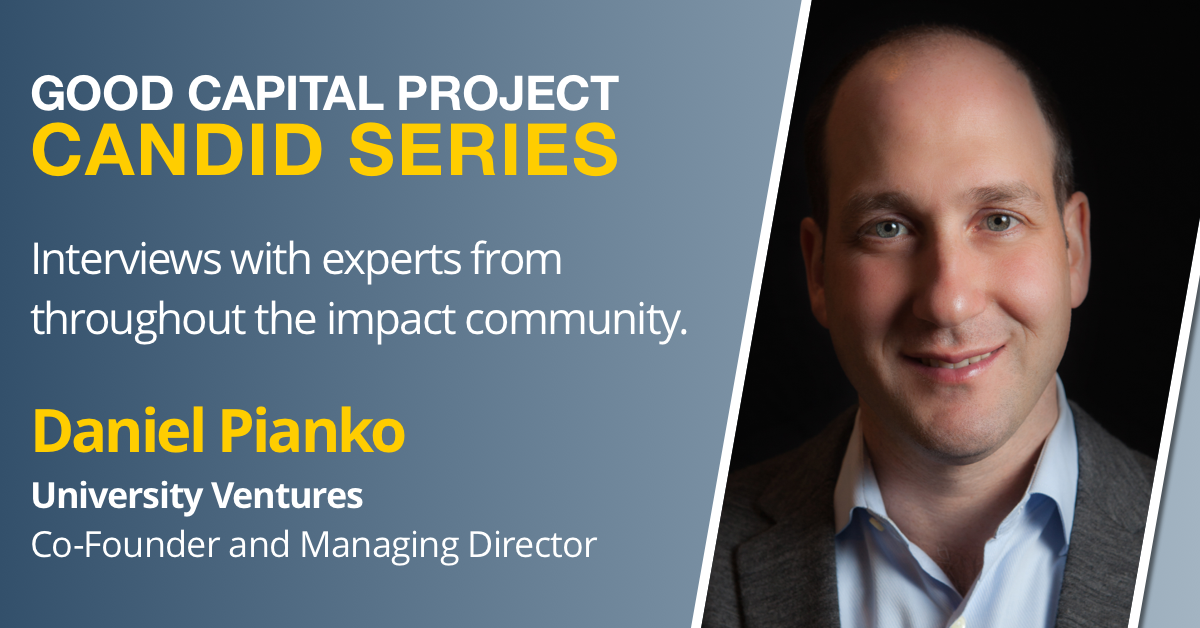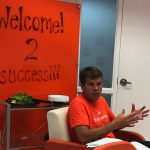
Daniel Pianko is Co-Founder and Managing Director of University Ventures. University Ventures is reimagining the future of higher education and creating new pathways from education to employment. UV portfolio companies are making higher education more affordable, pioneering entirely new approaches to learning, and helping employers think differently about how and where they discover talent. UV’s approach draws upon the values and traditions of higher education to play a sustainable role in transforming the path from education to a stronger economic future for students, universities, and employers.
Good Capital Project: How does University Ventures leverage design-thinking to invest in the human capital development market?
Daniel Pianko: Our goal is to reimagine the future of higher education. We utilize a design-thinking approach, which means we start with the ‘answer.’ In our case, the ‘answer’ for the vast majority of people who enroll in higher education institutions is they want a good first job, or a better job. While some students attend higher education for personal advancement and intellectual curiosity, study after study shows over 90% of students attend higher education to improve their lives economically.
Much of what we do is focus on the practical, non-cognitive skills and soft skills that are necessary to be successful in a professional environment. Today, employers are increasingly looking for employees who can hit the ground running — and most colleges and universities don’t teach critical digital skills and many other skills employers look for. We call this last-mile training which is essential in today’s job market.
Frequently, human resource officers look for new hires with a list of specific competencies that are critically important to being successful in that job. For example, to get an entry-level sales job an applicant needs to have knowledge of Salesforce. Salesforce is a common platform used by many companies – if the applicant is not familiar with this technology, they won’t get the position. We put in the mechanisms for last-mile training to help students learn these critical skills enabling them to get a good first job.
GCP: Most people associate the phrase ‘last-mile’ with development investment or last-mile problems delivering services in underdeveloped countries. University Ventures uses ‘last-mile’ to provoke a mentality that schools are unable to provide students with the skills that jobs actually require. This speaks to a disconnect between education, preparedness, and efficacy in a job. What does last-mile training mean to you?
DP: Last-mile training is frequently the most valuable part of the ecosystem. At University Ventures, the phrase ‘last-mile” refers to a combination of technical or digital training and non-cognitive skills development and then placing candidates.
I believe last-mile training is critical because there has been misalignment between hiring managers and prospective employees. Hiring managers want someone with specific skills to show up at an appointed time. Unfortunately, that’s not how we set up our ecosystem of job placement.
There are some reports by Strada Education and Gallup that shows people who do not obtain a good first job are more likely to be underemployed for the rest of their lives. We define a good first job as one paying over $50,000, with clear pathways for career progression, and in a growing sector of the economy. People paid thousands of dollars for their higher education, but if they don’t obtain a good first job, there is a 50% chance they will remain underemployed a decade later.
Colleges portray this image of training students for their 5th job, but doing that relegates a large portion of graduates to never having a great career because they have been underemployed since graduation. The goal for the vast majority of people in higher education is a good first job. University Ventures has developed this organizing principle to create pathways to those good first jobs.
GCP: What is a successful example of this approach from one of your portfolio companies?
DP: Our ‘eureka moment’ was when we realized the real friction was around the employer. We invested in a staffing company, called Revature, and helped them partner with traditional universities to create pathways to coding jobs. Revature had connections to employers and staffing relationships, which helped us stay updated on big needs in a particular market.
Once we get a lead on upcoming jobs, we identify rising seniors and put them through a job training program, which we offer for free. We created free bootcamps in conjunction with colleges and universities to create a pipeline of talent into high quality coding jobs. This is an example of how we radically reduced the friction around the employers because they could take a risk on who they hire.
Often for students, this becomes a temp-to-perm job. These students work for a year or two on the job site. Upon completion, the company has the opportunity to hire the students full-time in senior positions. If the first 6 months don’t work out – the company also has the option to not hire that person. However, if the student stays for a full year on the project, then they are highly likely to be hired. The result is a friction-less pathway for both candidates and employers.
GCP: How much of your portfolio is trying to solve this problem of a good first job?
DP: We have 8-10 companies in our portfolio that have some version of direct, connected-to-employer education tied to getting a good first job. One company we invest in, Techtonic, utilizes the Outsourced Apprenticeship Model to achieve this goal. They work with workforce boards to identify diverse low income talent and integrates the top applicants into a software development training program.
Within a short period of time, students are billed out to clients (at lower rates to start) with the ultimate expectation of being hired by that company once they get comfortable with the candidate’s workproduct. The Outsourced Apprenticeship Model is solving two problems for the company – they’re getting their product built and they’re establishing a novel pipeline for diverse talent. This is a great example of education investing extending into brave new areas of workforce development.
GCP: Will this always be a private sector addendum to universities or do you see this ultimately having an influence on how universities structure their programs?
DP: We don’t think the university system is going to go away. We think universities are going to evolve, but the infrastructure is fundamentally going to stay the same.
The issue underlying our “future of work crisis” is that we have a ‘many’ to many to many problem. Approximately 50-60 million people in the U.S. are underemployed, unhappily employed, or unemployed. We have 4,000+ colleges/universities and millions of employers. It’s no wonder employers have so much trouble finding qualified labor.
We believe there will be a series of last-mile intermediaries connecting these dots. The future will be industry-specific training organizations that will partner with universities and global workforce boards to provide clear, concrete pathways to employment. Some colleges already implement such programs and work with local employers to create pathways. The exceptions, for the most part, prove the rule.
GCP: Well, that sets up a very broad and in-vogue question. What’s the future of work?
DP: Our job economy is going to go from pedigree-based hiring to competency-based hiring. We are talking about a massive shift towards competencies meaning something, where hiring managers will care a lot more about what a future employee can do vs. what college they attended.
We are seeing companies, universities, and nonprofit organizations create badges. Once badges can be catalogued and compared to a specific competency, employers won’t need applicant tracking systems or verifications. Companies will also be able to discover a far broader array of people than current models.
For example, we invested in Credly, which is the market leader in digital credentialing and badging. This concept of moving from pedigree-based to competency-based education is dependent on being able to categorize and identify, which is something incredibly important that Credly does.
GCP: How can someone’s career prospects and our economy improve when we have a greater proportion of the workforce able to demonstrate their competencies based on a standardized system? What does this mean for the general workforce if we are able to implement these solutions?
DP: In our current economy, about 10 million people have left the workforce since the 2008 recession. The only way we are going to solve this worker shortage is by bringing people back into the economy. Implementing these solutions will create pathways for many disaffected high potential employees to return to the workforce.
We have a massive social need to diversify our workforce, but people who don’t have access to degree programs can’t participate in the modern economy. These competency-based solutions allow companies to radically diversify their workforce away from people who happen to be good at getting into college.
Many problems in this country are driven by people who feel left out of the economic workforce. The only answer society has for this issue is for people to go back to school or college. However, traditional school probably already didn’t work for them and it’s not the right place for you to develop skills for a variety of reasons. It is imperative to come up with a faster, cheaper way for people to obtain employment. If we are unable to do that, we will continue to have this social discontent that the system isn’t working.
GCP: What are some of the costs of this problem?
DP: I’m going to let you in on some staggering economic realities – the average hospital spends about $80k to recruit a nurse, which is insane. To fill a software development position, the average cost to employers is $30k (the price of advertising for employees, managing the hiring process, etc). I can run someone through a bootcamp and staff the company on a temp-to-perm basis for half the cost. Employers are spending a lot of money on ways to attract the same, small subset of people who know specific programming languages. It’s more cost-effective to identify people in local geographies who have the cognitive capabilities to learn specific job skills.
GCP: How can governments – local, state, or federal – work with the private sector to develop more robust alternate pathways to employment that don’t necessarily require higher education?
DP: I don’t think the government should go near this. I believe the government should think through the unintended consequences of its actions to date. Then on a gradual basis, consider ways to increase access to the funding mechanisms we already have rather then push into this evolving ecosystem.
I think the government heavily subsidizes certain historically important job-training systems that aren’t necessarily important anymore. For example, apprenticeships are great concepts that work in Europe, but we don’t have them in the U.S. Our society only has apprenticeships relegated to very traditional, blue-collar jobs. Techtonic, which I mentioned before, actually developed the first apprenticeship program in software development approved by the Department of Labor. Now, we qualify for Workforce Investment Board dollars for software training.
There are two types of friction happening right now in the market. The first is education friction, where it costs a lot of money to go to school so many students opt not to return to school. Then there is employer friction, in which employers want to get the right person at the right time to fill the exact position they have available. The government subsidizes almost solely traditional college education programs stuck in a prior generation and life-cycle of the economy.
GCP: Regardless of the public sector, it sounds as though you believe the market is presenting a lucrative business opportunity to solve this problem?
DP: Yes, and that’s why we are able to see a return on our investment.
The government should provide every citizen in our country a certain level of cognitive skills and education in which they can be successful in last-mile training and obtain a job. The problem we face as a nation is our government does not do a good job with K-12 education, especially considering drop-out rates. About 50% of people who attend 4-year schools don’t graduate within 6 years and about 70% of people who attend 2 year schools don’t graduate in 3 years. Basically, we have dropout factories for higher education. They should use funding mechanisms to improve our existing system and find ways to foster development for last-mile training providers.
GCP: Do you consider University Ventures a social venture capital firm?
DP: We don’t think of ourselves as social entrepreneurs. We think of ourselves as creating market-leading returns by solving one of America’s greatest social problems.
I believe social impact is all about aligning the various aspects of a business around creating immense social and economic value. Last-mile training providers have one very simple metric – getting people good jobs.
GCP: It sounds like your approach is to identify business opportunities in solving social problems. In other words, solving social challenges presents opportunities to make money.
DP: I actually wrote a piece about this for ImpactAlpha. We believe that by solving great social problems, we should have market-beating returns. And that’s what we are seeing.
One of the most difficult things about social impact investing is people automatically assume it’s donative capital or philanthropy. There is an important role for social ventures in society that are philanthropic and donative. However, they need to be a completely different category than those who are achieving market returns while solving the world’s great problems. Social impact investing will always be relegated to the sidelines if it is considered donative or philanthropic capital.




